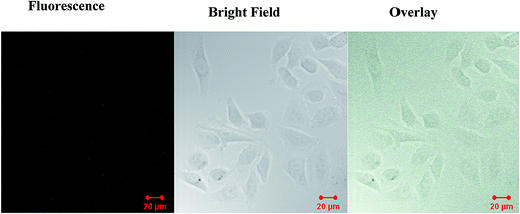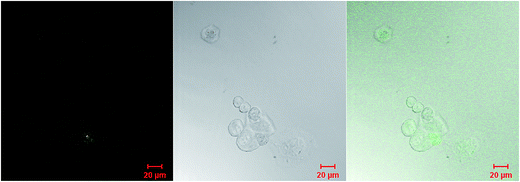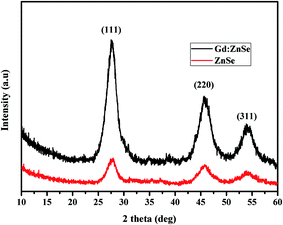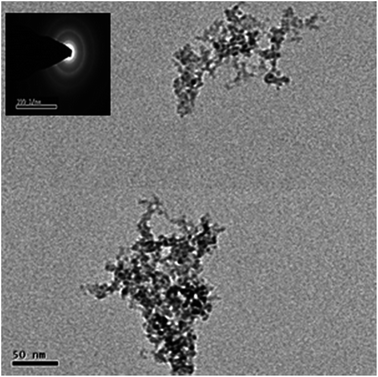Synthesis and characterization of gadolinium-doped ZnSe quantum dots for fluorescence imaging of cancer cells
S. Sureshkumara,
B. Jothimania,
T. M. Sridharb and
B. Venkatachalapathy*c
aDepartment of Chemistry, Rajalakshmi Engineering College, Thandalam, Chennai – 602 105, India
bDepartment of Analytical Chemistry, University of Madras, Maraimalai Campus, Guindy, Chennai – 600 025, India
cSRM Easwari Engineering College, Ramapuram, Chennai – 600089, India. E-mail: bv1461967@gmail.com
First published on 25th January 2016
Abstract
Gadolinium-doped ZnSe (Gd:ZnSe) quantum dots (Qds) were synthesized using ethylene glycol as a stabilizing agent. The fluorescence spectrum exhibited an emission peak at 435 nm for ZnSe, whereas the Gd-doped ZnSe exhibited a green emission at 547 nm. In vitro imaging studies of MCF-7 cancer cells were carried out using fluorescent probes constructed using Gd-ZnSe folate.
Breast cancer is a serious health issue and major cause of death among women around the globe.1 Semiconductor nanomaterials, also known as Qds, possess great physical and chemical properties making them suitable candidates as alternative fluoroprobes in the imaging and diagnosis of cancer.2,3 Cadmium-based semiconductors such as CdSe and CdS show high quantum yields and good photostability. They are color-tuneable, highly stable and exhibit zero scattering.4 However, these cadmium-based Qds are highly toxic and cannot be used for biological and medical applications.5 Therefore, it is essential to prepare less cytotoxic Qds with more biocompatibility, higher luminescence and higher photo stability. Recently, non-cadmium based low-toxic ZnSe based nanostructures have been reported as a distinctive material for fluorescent labels, biological assays, imaging of cells and tissues, and in vivo investigations.6
ZnSe possesses a wide band gap with a bulk band gap of 2.7 eV at room temperature7 and therefore is used in the fabrication of optoelectronic devices, solar cells,8 LED9 and biological labelling.10 Though ZnSe possesses interesting physical and chemical properties, it has very low fluorescence properties. For biological applications such as cancer cell imaging, fluorescence emission properties would preferably be above 500 nm. Therefore, it is essential to enhance ZnSe fluorescence emission for biological cell imaging applications.
Metal ion doping into Qds is usually carried out using highly poisonous chemicals and reagents; moreover, Qds are also prepared by organometallic routes. Recent results showed that the metal ion-doped ZnSe quantum dots were obtained under high temperatures using toxic chemicals and reagents. The Qds prepared by organometallic routes are more stable, but cannot be directly dispersed in the water phase due to their hydrophobic nature. To convert them to have hydrophilic surfaces and to obtain a water dispersible compound, surface modification is required. Recent studies showed that the higher luminescence of water-dispersible ZnSe nanocrystals can be developed in an aqueous solution.12,13
The rare earth metal ion Gd has been proved to be excellent when doped into the ZnO matrix, resulting in enhanced fluorescence properties, as reported by Yanlan Liu et al.11 Moreover, Qds optical properties can be tuned from visible to near infrared by changes in particle size (∼<30 nm). Qds exhibit different color emissions with changes in size.14 The PL energy of the Gd3+-doped CdSe Qds observed a red shift when compared with undoped CdSe Qds; this was due to the increased diameter of the Gd3+-doped CdSe Qds when compared with undoped CdSe Qds.15 To tune the emission properties, ZnSe may be doped with a suitable element to increase the emission characteristics of ZnSe. Therefore, we have chosen Gd as the dopant and prepared gadolinium-doped ZnSe quantum dots modified with (3-aminopropyl)triethoxysilane (APTES) and conjugated it to folic acid as a fluorescent probe to image cancer cells in vitro. This method is cost effective and simple when compared to organometallic synthesis; it has very low toxicity, high stability and can be prepared in bulk quantities. Experimental studies indicated that these fluorescent nanoprobes possess great potential in breast cancer cell imaging.
All chemicals and solvents used in this experiment were of analytical grade and were used without further purification. Ethylene glycol (99%), selenium powder (200 mesh, 99.9%), Zn(OAc)2·2H2O (99.9%), Gd(NO3)3·6H2O (99.9%), and NaBH4 (99%) were purchased from Aldrich Chemical Co., and APTES (99.9%) was purchased from Alfa Aesar. Minimum Essential Medium (MEM) was purchased from Hi Media Laboratories, Fetal Bovine Serum (FBS) was purchased from Cistron laboratories, trypsin, methylthiazolyldiphenyl-tetrazolium bromide (MTT) and dimethyl sulfoxide (DMSO) were purchased from SRL. All other chemicals and reagents were obtained from Sigma Aldrich. Millipore water was used in all experiments. The MCF-7 cell line was obtained from NCCS, Pune. The cells were maintained in MEM supplemented with 10% FBS, penicillin (100 Units mL−1), and streptomycin (100 μg mL−1) in a humidified atmosphere of 50 μg mL−1 CO2 at 37 °C.
Sodium hydrogen selenium (NaHSe) was prepared according to the synthesis method reported by Daniel L. Klayman et al.16
| 4NaBH4 + 2Se + 7H2O → 2NaHSe + Na2B4O7 + 14H2 |
10 mL of ethylene glycol was added slowly to 100 mL of 0.1 M Zn(OAc)2 under constant stirring into which freshly prepared NaHSe solution was injected immediately. The reaction was carried out under N2 atmosphere for about 8 hours and the temperature of the reaction mass was maintained at 100 °C. Finally, the obtained precipitate was isolated by centrifugation (5000 rpm). Gd:ZnSe Qds were synthesized by the same procedure with a slight modification, i.e., 10 mL of 0.01 M Gd(NO)3·6H2O was taken along with 90 mL of 0.1 M Zn(OAc)2.
Gd:ZnSe Qds were dispersed in 10 mL of toluene into which 1 mL of APTES in ethanol was added and stirred at room temperature for 30 minutes. Then, the reaction mixture was refluxed at 80 °C for 30 minutes. The obtained APTES modified Gd:ZnSe APTES-Gd:ZnSe Qds were purified by centrifugation followed by washing with ethanol. Finally, the purified Gd:ZnSe Qds were re-dispersed in water in the dark for further experiments.
0.05 mM of folic acid (FA) in DMSO was added to 10 mg of APTES-Gd:ZnSe Qds in CH2Cl2 (10 ml) in presence of N,N′-dicyclohexylcarbodiimide (DCC) (0.05 mM). This mixture was stirred for 30 minutes at room temperature. The obtained product (FA–APTES-Gd:ZnSe) was separated by centrifugation and then washed with CH2Cl2.
The MTT assay was carried out to evaluate the cell viability of MCF-7 upon FA–APTES-Gd:ZnSe Qds treatment. The concentration of Qds was determined based on previous literature.17 A wide range of concentrations were taken to assess the viability. Cells (1 × 105 per well) were plated in 24-well plates and incubated at 37 °C with 5% CO2. At confluence, various concentrations of the nanoprobes were added and incubated for 24 hours. After incubation, the medium was removed from the wells and the cells were washed with phosphate buffered saline. MTT was added and incubated for 4 hours. After incubation, 1 mL of DMSO was added in all the wells to dissolve the formazan crystal formed and the absorbance was measured at 570 nm with a UV-spectrophotometer. Measurements were performed and the concentration required for a 50% inhibition (IC50) was determined graphically. The percentage cell viability was calculated using the formula as follows: % cell viability = mean of absorbance of treated group/mean of absorbance of control group × 100%.
Cells were cultured on sterile cover glasses in DMEM containing 62.5 μg mL−1 of FA–APTES-Gd:ZnSe for 1 h and 6 h at 37 °C in a humidified atmosphere containing 5% CO2. Before imaging, the medium was discarded and washed with phosphate buffered saline (PBS) to remove excess probes.
The X-ray diffraction pattern of the prepared QDs was characterized with a Bruker D-8 Advance X-ray diffractometer (Cu Kα (1.5418 Å)). UV–vis absorption spectra were obtained using a Shimadzu RF-5301. Fluorescence measurements were performed on an Agilent Varian Cary Eclipse spectrophotometer (FL1201M002). In both experiments, a 1 cm pathlength quartz cuvette was used. Surface morphology and size were examined by HRTEM (FEI-TECHNAI, G2-Model (T-30 S TWIN)) with an accelerating voltage of 250 kV and elemental analyses were carried out by EDAX. A FTIR spectrophotometer (Perkin Elmer spectrum-II) was used to characterize the folic acid conjugated Gd:ZnSe Qds. The QDs-labelled MCF-7 cells were imaged using a confocal microscope (Zeiss LSM 510 META). The ZnSe and Gd:ZnSe were prepared in an aqueous solution by the nucleation doping strategy.18,19 Zinc acetate, gadolinium nitrate and Se powder were taken as precursors to prepare the QDs. Gadolinium-doping of ZnSe QDs was achieved by partially replacing zinc acetate with gadolinium nitrate. Fig. 1 shows the XRD pattern of the ZnSe and Gd-doped ZnSe QDs. ZnSe QDs show the diffraction peaks that correspond to a zinc blend structure with JCPDCS card no. 37-1463. Gd-ZnSe also exhibited similar phase structures and lattice parameters, which are consistent with that of ZnSe. From the results, we observed the diffraction pattern does not show any peaks of secondary phases of gadolinium such as Gd2O3. It was also indicated that the diffraction peak intensities are affected by doping Gd onto the ZnSe matrix. The diffraction intensity might decrease by doping with smaller atoms. However, doping with larger Gd3+ atoms result in more scattering centres and therefore results in increased peak intensities.20 This confirms that the dopant Gd was present in the ZnSe matrix. The crystallite size of ZnSe and Gd:ZnSe Qds was calculated using Scherrer's equation and was found to be 3.5 and 8 nm, respectively.
Fig. 2 shows the optical absorption feature of ZnSe and Gd:ZnSe Qds. A sharp absorption peak appears at 362 nm for ZnSe, whereas Gd-doped ZnSe shows 365 nm, indicating that the injected metal ions are isomorphic to Zn2+ ions and decrease the band gap.
Fig. 3 shows the corresponding fluorescence emission spectra of ZnSe and Gd:ZnSe QDs excited at 350 nm. The emission spectrum of ZnSe Qds shows bands at 435 nm. The Gd:ZnSe QDs show emission at 547 nm. This is attributed to the increased in particle diameter when compared with un-doped ZnSe QDs. These enhanced emission bands indicated that the Gd3+ is trapped in the ZnSe matrix.
 | ||
| Fig. 3 Fluorescence emission spectra of (a) ZnSe Qds and (b) Gd:ZnSe Qds (inset: image of (a) ZnSe Qds and (b) Gd:ZnSe Qds irradiated under UV; λ – 360 nm). | ||
The presence of ethylene glycol as a stabilizing agent provides stability and size control of the Gd:ZnSe Qds. Fig. 4(a) shows the high-resolution TEM image of the Gd-doped ZnSe Qds, confirming the size of the Qds at 8 nm. Fig. 4(b) shows the corresponding selected area diffraction (SAED) pattern of the Gd:ZnSe Qds. From these studies, it was found that the prepared Gd:ZnSe Qds crystals are grown with a well-defined cubic structure and SAED pattern consisting of discrete and bright rings. This indicates that the prepared Qds are amorphous in nature, which might be due to the organic moiety on the surface of the Qds. The SAED pattern also confirms that zinc blended-structured Gd:ZnSe Qds grow along the (200) direction.
Compositional analysis of the Gd:ZnSe Qds was carried out by EDAX. Fig. 5 shows a typical EDAX spectrum of the Gd:ZnSe Qds. The presence of zinc and selenium along with gadolinium can be observed, which is in agreement with the results obtained with X-ray diffraction analysis. The quantitative analysis of Gd present on Gd:ZnSe Qds was obtained from Inductive Coupled Plasma Emission Spectrometry (ICP-OES) and indicated the presence of gadolinium (6.64 mg L−1), zinc (626 mg L−1) and selenium (173 mg L−1).
For fluorescence imaging application, Gd3+-doped ZnSe Qds were modified with APTES and then was conjugated with folic acid using the DCC cross-linking reagent. Fig. 6 shows the FT-IR spectra of Gd:ZnSe Qds, APTES-Gd:ZnSe Qds, and FA–APTES-Gd:ZnSe Qds. In Fig. 6, the peak at 3441 cm−1 is OH stretching and the peaks at 2878 cm−1 and 1464 cm−1 indicate CH bending that is attributed to the presence of ethylene glycol over the Gd:ZnSe surface.
The APTES-Gd:ZnSe Qds showed a weak band at 2923 cm−1, which can be assigned to the alkyl groups [(CH2)n] present in APTES. The absorption band at 1561 cm−1 is attributed to an NH2 scissor vibration, suggesting the presence of the amino groups of APTES molecules in the terminal position of the propyl chain. In addition, the broad band at 1116 cm−1 is probably attributed to the stretching vibration of Si–O–Si. All these facts suggest that APTES has been successfully linked to the surface of Gd3+-doped ZnSe QDs. FA–APTES-Gd:ZnSe Qds showed the characteristic IR absorption peaks of FA at 1605 cm−1 (benzene, conjugated double absorption), 1697 cm−1 (ester bond), and 1481 cm−1 (hetero-ring, conjugated double bond), which confirms that folic acid was conjugated with FA–APTES-Gd:ZnSe Qds.
Folic acid conjugated on gadolinium-doped ZnSe Qds is schematically illustrated in Fig. 7. Fig. 8 shows the toxicity effects of varying concentrations from 0 to 250 μg mL−1 of FA–APTES-Gd:ZnSe nano fluorescence probes on MCF-7 cell viability using an MTT assay.
 | ||
| Fig. 7 Schematic for the synthesis of folate-conjugated APTES-modified Gd3+-doped ZnSe Qds fluorescence probes. | ||
The concentration (0 to 250 μg mL−1) dependent effect of FA–APTES-Gd:ZnSe probes on MCF-7 cell viability was measured using an MTT assay and the results are shown in Fig. 8. MCF-7 cells were cultured in FA–APTES-Gd:ZnSe probe containing medium for 24 hours and 48 hours. The results suggest that the cell viability decreased in a dose dependent manner. Even at higher concentrations of 31.2 μg mL−1 FA–APTES-Gd:ZnSe probes, the viability of MCF-7 cells was above 92%, thus making it suitable for use in biological systems due to its low cytotoxicity. From these results, we can conclude that the obtained Qds fluorescence probe can be a better alternative to organic fluorescent probes for imaging in vitro due to its low cytotoxicity.
The internalization of the FA–APTES-Gd:ZnSe Qds by MCF-7 was further established by confocal microscopy from Fig. 9–13. Fig. 9 and 11 shows the confocal microscopy images of MCF-7 after 1 hour and 6 hours incubation without adding FA–APTES-Gd:ZnSe Qds. No fluorescence was observed. Fig. 10 shows MCF-7 after 1 hour incubation co-cultured with FA–APTES-Gd:ZnSe Qds. It can be observed that green fluorescence emission was slightly observed. Fig. 12 shows confocal microscope images of MCF-7 co-cultured with FA–APTES-Gd:ZnSe Qds after 6 hours of incubation. This indicates the ability of the FA–APTES-Gd:ZnSe Qds (62.5 μg L−1) to penetrate cancer cells and serve as an internal fluorescence label that shows green fluorescence. FA was conjugated onto the APTES-Gd:ZnSe surface of nanoparticle carriers to deliver therapeutic agents within cells via receptor mediated endocytosis. MCF-7 cancer cells have over-expressed folic acid receptors and have high requirements for folic acid.21 Qds can enter into the intracellular cytoplasm via endocytosis and selectively deliver the Qds to MCF-7 cells and to label them. Folic acid is required for the uptake of Qds by cancer cells. In Fig. 10 and Fig. 12 shows that only folic acid conjugated Qds are taken up by the cancer cells, whereas non conjugated Qds are not taken up by cancer cells which are showed in Fig. 13.
 | ||
| Fig. 9 Confocal microscopy images of MCF-7 after 1 hour of incubation (without adding FA–APTES-Gd:ZnSe Qds). | ||
 | ||
| Fig. 10 Confocal microscopy images of MCF-7 after 1 hour of incubation co-cultured with FA–APTES-Gd:ZnSe Qds. | ||
 | ||
| Fig. 11 Confocal microscopy images of MCF-7 after 6 hours of incubation (without adding FA–APTES-Gd:ZnSe Qds). | ||
 | ||
| Fig. 12 Confocal microscopy images of MCF-7 co-cultured with FA–APTES-Gd:ZnSe Qds after 6 hours of incubation. | ||
 | ||
| Fig. 13 Confocal microscopy images of MCF-7 co-cultured with APTES-Gd:ZnSe Qds after 6 hours of incubation. | ||
The MTT assay and fluorescence studies revealed that the obtained Qds fluorescence probe can be a better alternative to organic fluorescence probes for imaging in vitro due to its low cytotoxicity.
Conclusion
In summary, Gd:ZnSe Qds were synthesized by a simple wet chemical route using ethylene glycol as a stabilizer. The prepared Gd:ZnSe Qds exhibited an emission at 547 nm which is due to increase in size of Gd:ZnSe compared to that of ZnSe. The method used was a convenient, efficient method to obtain the rare earth metal ion-doped ZnSe nanomaterial that can be directly dispersed in the water phase. The average size of Qds was about 3.5–8 nm as confirmed by HRTEM analysis. Gd-doped ZnSe Qds were indexed to cubic zinc-blend ZnSe crystals. EDAX analysis further confirms Gd3+ ions were present in the synthesized Gd:ZnSe Qds. Very low cytotoxicity effects of FA–APTES-Gd-ZnSe Qds on the MCF-7 cell lines were observed by the MTT assay. The obtained Qds fluorescence probes can be a better alternative to organic fluorescence probes for imaging of MCF-7 cancer cells in vitro due to their low cytotoxicity and ease in preparation.Acknowledgements
The authors wish to thank AICTE for funding under the RPS scheme No. 8023/BOR/RID/RPS-15/2009-10 and Dr N. Rajendran, Prof., Dept of Chemistry, Anna University, Chennai, India for his help with FTIR-ATR measurements.References
- S. S. Coughlin and D. U. Ewkueme, Cancer Epidemiol., 2009, 33, 315 CrossRef PubMed.
- V. M. Yezhelyev, X. Gao, Y. Xing, A. Al-Hajj and S. Nie, Lancet Oncol., 2006, 7, 657 CrossRef PubMed , Regan OMR.
- C. Warren, W. Chan and S. Nie, Science, 1998, 281, 2016 CrossRef.
- N. Pradhan and X. Peng, J. Am. Chem. Soc., 2007, 129, 3339 CrossRef CAS PubMed.
- C. Kirchner, T. Liedl, S. Kudera, T. Pellegrino, J. A. Munoz and H. E. Gaub, Nano Lett., 2005, 5, 331 CrossRef CAS PubMed.
- C. Wang, X. Gao, Q. Ma and X. Su, J. Mater. Chem., 2009, 19, 7016 RSC.
- A. Sadao and T. Tsunemasa, Phys. Rev. B: Condens. Matter Mater. Phys., 1991, 43, 9569 CrossRef.
- J.-Y. Jung, K. Zhou, J. H. Bang and J.-H. Lee, J. Phys. Chem. C, 2012, 116, 12409 CAS.
- M. A. Hines and P. G. Sionnest, J. Phys. Chem. B, 1998, 102, 3655 CrossRef CAS.
- C. Wang, X. Gao, Q. Ma and X. Su, J. Mater. Chem., 2009, 19, 7016 RSC.
- Y. Liu, K. Ai, Q. Yuan and L. Lu, Biomaterials, 2011, 32, 1185 CrossRef CAS PubMed.
- W. C. W. Chan and S. Nie, Science, 1998, 281, 2018 CrossRef.
- N. Murase and M. Gao, Mater. Lett., 2004, 58, 3898 CrossRef CAS.
- D. Bera and L. Qian, Holloway, P.H. InformaHeathcare: New York, NY, USA, 2009, vol. 191 Search PubMed.
- I.-F. Li and C.-S. Yeh, J. Mater. Chem., 2010, 20, 2079–2081 RSC.
- D. L. Klayman and T. Scott Griffin, Walter Reed Army Institute of Research, Washington, D. C, 1972, p. 16 Search PubMed.
- Z. Yu, X. Ma, B. Yu, Y. Pan and Z. Liu, J. Biomater. Appl., 2012, 1–9 Search PubMed.
- N. Pradhan, D. Goorskey, J. Thessing and X. Peng, J. Am. Chem. Soc., 2005, 127, 17586 CrossRef CAS PubMed.
- N. Pradhan and X. Peng, J. Am. Chem. Soc., 2007, 129, 3339 CrossRef CAS PubMed.
- P. K. Sharma, R. K. Dutta, R. J. Choudhary and A. C. Pandey, CrystEngComm, 2013, 15, 4438–4447 RSC.
- A. Bamezai, V. S. Goldmacher and K. L. Rock, Eur. J. Immunol., 1992, 22(1), 15–21 CrossRef CAS PubMed.
| This journal is © The Royal Society of Chemistry 2016 |







